Sea Cadets (United Kingdom)
| Sea Cadet Corps | |
|---|---|
 | |
| Founded | 1856[1] |
| Country | United Kingdom |
| Branch | Royal Navy |
| Type | National youth charity |
| Size | 13,730 Cadets (as of 1 April 2023)[2] 4260 Adult Volunteers 6 regional watersports centres 5 offshore vessels 4 national training centres |
| Headquarters | London |
| Motto(s) | Ready Aye Ready |
| Website | Sea Cadets |
| Commanders | |
| Admiral of the Sea Cadet Corps | The Princess Royal |
| Captain Sea Cadets | Capt Neil Downing RN |
| Insignia | |
| Ensign |  |
| Badge |  |
| UK Military Cadet Forces military component of the youth organisations in the United Kingdom |
|---|
| Components |
| British Overseas Territories |
| Former Components |
| Personnel |
| Allegiance |

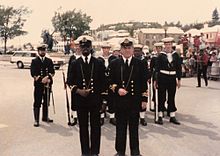
The Sea Cadet Corps is a national youth charity. It is present in England, Scotland, Wales, Northern Ireland,[5] Malta and Bermuda. Cadets follow an ethos, training plan and rank structure similar to that of the Royal Navy, and are recognised by the UK Ministry of Defence.
History
In 1854, a Vicar in Whitstable, Kent returned from the Crimean War and founded an orphanage where sailors taught nautical skills to prepare orphans for future careers. Multiple similar orphanages were founded across the country, and the organisation became known as the Naval Lads' Brigade. In 1899 Queen Victoria presented £10 (around £1,000 today) to the Windsor Unit to purchase uniforms.[6]
In 1910 The Navy League sponsored a small number of units as the Navy League Boys' Naval Brigade, and in 1919 the organisation adopted the name Navy League Sea Cadet Corps. Lord Nuffield donated £50,000 in 1937 to fund an expansion of the Corps.[6] By the outbreak of World War II, there were 100 Units across the UK with more than 10,000 Cadets.
King George VI became the Admiral of the Corps in 1942 and the name was changed to the Sea Cadet Corps. The Sea Cadets had approximately 400 Units and 50,000 Cadets. The Girls Naval Training Corps was formed as well (later renamed Girls Nautical Training Corps in 1950).[6] Queen Elizabeth II became the Patron of the Sea Cadets in 1952.[6] In 1955 the Sea Cadet Council agreed to the formation of the Marine Cadet Section.[6] The Girls Nautical Training Corps became affiliated with the Sea Cadet Corps in 1963. The Royal Naval Association began planning the first British colonial unit in Bermuda in 1964, with TS Bermuda formed on 12 January 1966.[7] Located at Admiralty House, Bermuda, it was followed by two further units (TS Venture at the former Roman Catholic chapel of the Royal Naval Dockyard, Bermuda and TS Admiral Somers at Convict Bay, St. George's, another former Admiralty property).[8]
On 31 March 1980 the Ministry of Defence approved the admission of girls into the Sea Cadet Corps. The successful integration of girls into the Sea Cadet Corps led to the dissolution of the Girls Nautical Training Corps in 1992.[6]
Ethos
The Sea Cadets' ethos is made up of three parts: its values, its mindset, and the customs and traditions of the Royal Navy. The promise made by every cadet who joins the Sea Cadet Corps is as follows:
The Sea Cadet Promise: I promise to serve my God, my King, my country, and, the Sea Cadet Corps and to obey the orders of my superior officers. I will be proud of my uniform and be smart and seamanlike in wearing it, and, always do my duty.[9] Note: My God refers to an individual’s own faith and is intended to apply equally to those from all faiths or none. (Sea Cadets' Ethos, 2019, p4)
The ethos is underpinned by the Sea Cadet Values which are: Courage, Commitment, Discipline, Respect, Loyalty, Honesty, and Integrity.[10] These are taught by staff throughout the time cadets are with a unit, there is also an expectation that Chaplains will take a lead in such delivery.[10]
Cadets
Junior Sea Cadets
For 9 to 12-year-olds, Junior Cadets have their own training programme and uniform, based on a more practical version of the Sea Cadets training programme.[11][12] When Junior Sea Cadets turn 12 years old, they can move up to being a New Entry to learn the New Entry courses, before moving up to become a Sea Cadet.
Sea Cadets
For 12 to 18-year-olds, young people can join as a Sea Cadet and work their way up through the training programme.[11] When cadets turn 18, they can either leave the Corps or they can stay and train as staff.
Royal Marines Cadets
For 13 to 18-year-olds, the Sea Cadets has detachments of Royal Marines Cadets.[11] They follow a more infantry-based syllabus including fieldcraft; section battle drills, fire and manoeuvre, and general patrolling including reconnaissance missions, ambush, and fighting patrols. Other Royal Marines Cadets exist in the Volunteer Cadet Corps and Combined Cadet Force.

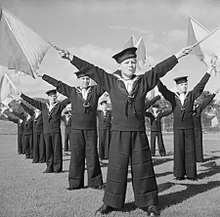
Admiral of the Sea Cadet Corps
| Appointee | From | to |
|---|---|---|
| King George VI | 1942 | 1952 |
| Prince Philip, Duke of Edinburgh | 1952 | 1992 |
| Prince Andrew, Duke of York | 1992 | 2019 |
| Princess Anne, Princess Royal | 2021 | Present |
Structure and organisation
National level

The Headquarters of Sea Cadets are in Lambeth, South London. Its departments deal with:
- Fundraising
- Safeguarding
- Finance
- Training
- Communications
- Events
Area level
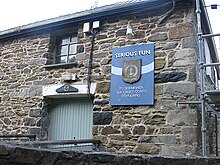
The country is divided into six areas, which are:
- Eastern (including Malta)
- Northern (including Northern Ireland and Bermuda)
- Southern (including the Channel Islands & Falkland Islands)
- North West (including the Isle of Man)
- London
- South West
Each area is run by an Area Officer (AO) with a small team of support staff.
District level
Each area is subdivided into districts of between five and twelve units which are led by volunteers.
Unit level
Each unit is led by a Commanding Officer. Some units also have a Royal Marines Cadets Detachment, headed by a detachment commander.
Volunteers fulfil roles such as water sports instructors, fundraisers, administrative staff, etc. Sea Cadets has both uniformed adult volunteers and non-uniformed adult volunteers.[13]
Each unit is a separate registered charity, affiliated to the Marine Society & Sea Cadets. The trustees are elected annually, except the Commanding Officer, who is appointed ex-officio. They form the Unit Management Team, responsible for providing the resources to safely carry out the training programme.
Training regime

Cadet Training Programme
The Sea Cadet Corps follows the Cadet Training Programme (CTP) which covers various water-based activities and skills as well as first aid and leadership with lots more. Royal Marine Cadets also complete the CTP but have additional elements such as camp craft and weapon handling, amongst others.
When you become the rating of Able Cadet (AC) you start a new syllabus called the LDP (Leadership and Development Programme). This is to perfect your leadership skills and teaching skills, this will also help if cadets are looking to become members of staff.
The Cadet Training Program is broken down by ratings. For example, a Cadet 1st Class (CFC) will complete the CFC to Ordinary Cadet (OC) training.
Specialisation and proficiency training
Skills learned in a cadet's time in the SCC usually fall into one of two categories - Specialisations and Proficiencies. Specialisations are often larger subjects than proficiencies, and so are split into three levels; Basic, Intermediate, and Advanced, each level increasing in difficulty by building on the knowledge gained from the prior levels. Basic specialisations are often gained at the unit during regular training, while Intermediate and Advanced awards are held on an Area or National basis.
Some specialisations and proficiencies, such as Marine Engineering, are also divided into disciplines such as Electrical and Mechanical engineering.
All of the following are on offer to cadets, either at the unit or on district/area/national courses.
| Specialisations | Proficiencies | Waterborne Proficiencies | External Qualifications |
|---|---|---|---|
| Marine Engineering (Electrical/Mechanical) | Piping | Dinghy Sailing | Duke of Edinburgh (Bronze/Silver/Gold/Ambassador) |
| CIS (Radio Communications/ Information Systems) | Meteorology | Rowing | BTEC Level 1 |
| Physical Training | Music | Power Boating | BTEC Level 2 |
| Catering | Adventurous Training (Hill Walking/Mountain Biking/Rock Climbing) | Paddlesports (inclusive of Whitewater kayaking, kayaking, canoeing, stand up paddleboarding, etc) | BTEC Level 2 in Teamwork and Personal Development in the Community |
| Navigation | Shooting (Full-bore/Small-bore/Air-rifle) | Windsurfing | CVQO Westminster Award |
| First Aid | Offshore Sailing/Power Boating | ILM Level 3 in Leadership and Management | |
| Seamanship | |||
| Drill |
Cadets may also work towards recognised qualifications including, Duke of Edinburgh's Award and BTEC qualifications. The BTECs are offered by CVQO, and include Teamwork and Personal Development in the Community (formerly Public Service), Music, and Engineering.
Many qualifications are run by the Sea Cadets but regulated by external bodies. In these cases, cadets earn independent qualifications that are recognised outside the Corps. These include paddle sport, where they can gain Paddle Power or Star Awards through British Canoeing (formerly known as BCU), First Aid, where they can earn St John Ambulance First Aid certifications, Rowing, where they can earn British Rowing (BR) qualifications and Powerboating/Sailing/Windsurfing/Navigation where they can gain Royal Yachting Association (RYA) qualifications. National courses are also held, often on Royal Navy bases, to teach skills such as leadership and teamwork. Specialist qualification courses include power boating in Scotland, cooking in Preston, and fire fighting in Cornwall. There are competitions at varying levels in many of the sports, proficiencies, and specializations of the SCC. Competitions start at a District level and progress through to the National level.
Ranks and rates
Cadets
From New Entry through to Able Cadet, Sea Cadets are promoted based on their completion of various task-based modules under the CTP - Cadet Training Programme. Leading Cadets and Petty Officer Cadets are required to attend and pass a promotion board (held at an area or national level) before being promoted. If they then go on to become an instructor they must join as a civilian instructor first, unless they were a Petty Officer Cadet then they will be able to join as a Probationary Petty Officer.
The ranks of Marine Cadet 2nd Class (MC2) and Marine Cadet 1st Class (MC1), which were equivalent to Ordinary Cadet and Cadet 1st Class respectively, were phased out at the end of 2018. The rank of Marine Cadet (MC) is now equivalent to all three Sea Cadet ranks of Cadet, Cadet 1st Class and Ordinary Cadet (OC).
All Royal Marines Cadets are required to complete boards for each promotion. The higher the board the higher the level the board is run at. The former promotions from Marine Cadet to Marine Cadet 2nd Class and to Marine Cadet 1st Class were run at the detachment level. Marine Cadet to Lance Corporal boards are at troop or company level, Lance Corporal to Corporal boards are at the company level, and Corporal to Sergeant boards are at a national level. All promotions boards have multiple sections all of which must be passed individually.
 Sea Cadets Corps |

|

|

|

|

|

|
No insignia | |||||
|---|---|---|---|---|---|---|---|---|---|---|---|---|
| Petty Officer Cadet |
Leading Cadet |
Able Cadet | Ordinary Cadet | Cadet 1st Class |
Cadet | New Entry | ||||||
| POC | LC | AC | OC | CFC | CDT | NE
| ||||||
 Royal Marines Cadets (Part of the SCC) |

|

|

|
No insignia | No insignia | |||||||
| Cadet Sergeant |
Cadet Corporal |
Cadet Lance Corporal |
Marine Cadet | Marine Cadet Recruit | ||||||||
| CDT SGT | CDT CPL | CDT LCPL | MC | MCR | ||||||||
Junior Cadets
 Junior Sea Cadets Corps |

|
||
|---|---|---|---|
| Leading Junior Cadet |
Able Junior Cadet |
Junior Cadet First Class |
Junior Cadet |
| LJC | AJC | JCFC | JC |
Adult officers
The following rates and ranks can be awarded to uniformed adult volunteers, there are also Non-uniformed Civilian Instructors (CIs) and Unit Assistants (UAs). From 2009 to 2019, if a person joined as a Civilian Instructor and wanted to be a uniformed member of staff, they would become an Acting Petty Officer or Sergeant, following a 6-month probationary period. From 2020, an adult can join as a uniformed member of staff as a probationary Petty Officer or Sergeant on completion of their application process.
Officers are commissioned under the Cadet Forces Commission.[14]

| Sea Cadet Corps officers | Captain (SCC) RNR[note 1] | Commander (SCC) RNR | Lieutenant Commander (SCC) RNR | Lieutenant (SCC) RNR | Sub-Lieutenant (SCC) RNR | Midshipman (SCC) RNR |
|---|---|---|---|---|---|---|
| Insignia | 
|

|

|

|

|

|
| Royal Marine Cadet Corps officers | Lieutenant Colonel (SCC) RMR[note 2] | Major (SCC) RMR | Captain (SCC) RMR | Lieutenant (SCC) RMR | Second Lieutenant (SCC) RMR | |
| Insignia | 
|

|

|

|

|
Another rank is Chaplain, they also commission under the Cadet Forces Commission.
| Rank | Chaplain (SCC) RNR |
|---|---|
| Insignia | 
|
Uniform
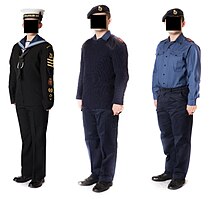
Cadets are issued two uniforms. Some units ask for a deposit for uniforms that is returned after the uniform is given back.
The two primary uniforms that cadets receive are:
Sea Cadets
- No. 1s (Formal Dress) - Seaman's Cap, Blue Class II Jumper, Blue Class II Trousers, Shirt Uniform Class II (white front), Seaman’s Blue Collar, Black Scarf Assembly, Lanyard, Black Boots/Shoes
- No. 4s (General Duty Rig) - Beret, Blue Jersey (worn in cold weather), Blue Working Shirt, Blue Working Trousers, Black Boots. No. 4s will gradually be decommissioned as the RNPCS takes over as General Duty Rig as of the 19th of July 2024.
- RNPCS (Royal Navy Personal Clothing System) - Beret, Blue Stable Belt, Blue Jersey (for use in cold weather), Black undershirt, Blue Working Jacket, Blue Working Trousers, Black Boots. As of the 19th of July 2024 the Sea Cadets have adopted RNPCS as the General Duty Rig. Many Sea Cadet units will operate using a variety of RNPCS and No. 4s as not every unit has received every item of clothing apart of RNPCS. Cadets are issued three badges to be sewn onto the uniform, one "Cadet Forces" badge, to be sewn onto the top seam of the left breast pocket. Cadets are also issued two "Sea Cadet Corps" shoulder flashes.

Marine Cadets
- No. 1s (Regimental Blue Dress) - Cap, Blue Tunic, Blue Trousers, White Belt, White Gloves, Black Boots
- No. 3B/3D (General Duty Dress) - Beret, Combat Jacket, Combat Trousers, Smock (worn in cold weather), Belt, Boots
There are also other uniforms cadets can wear like 2s (Evening Mess Dress). As well as 5s (Working Rigs) which consist of aviation dress, catering dress, and physical training dress. All uniforms except 4s and 5s are split into 3 categories A, B, and C which are used for different occasions.
Ships
The Sea Cadets have three classes of offshore vessels, all of which are capable of coastal/offshore passage making. Sea Cadet voyages normally last for 6 days, with cadets gaining RYA qualifications for their voyage. Individual Sea Cadet units also have various boats including MOD motor boats such as Vikings, Champs, Dories. Units may also have 1 or more ribs equipped with outboard engines, and possibly a rigiflex 360, in addition to vessels designed specifically for the SCC such as the Trinity 500 rowing boat and RS Quest dinghy. Also on loan from the MOD, canoes, kayaks, and windsurfing equipment. Larger Boat Stations and Training Centres have larger ribs and other vessels
Current offshore fleet
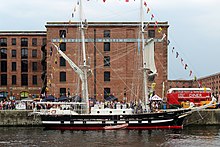
TS Royalist
TS Royalist, the Sea Cadet flagship, is a tall ship owned by the MSSC. She is used to providing week-long training courses for Sea Cadets and Royal Marines Cadets. The ship was launched in 2014 to replace the previous TS Royalist, which was over 40 years old when decommissioned. In 2013 there had been an appeal to replace the ageing flagship: £250,000 was needed this target was achieved in April 2013.[15]
She is rigged as a 34m brig,[16] with a sail area of 536 square metres (641 sq yd). Her draught is 3.25 metres (10 ft 8 in).[17] The ship's hull is of high tensile steel, with her superstructure of glass reinforced plastic. She has a crew of eight, plus up to twenty-four Cadets and two adult trainees. Twelve passengers can also be carried.[18]
TS City of London and TS Sir Stelios
TS City of London and TS Sir Stelios is the Sea Cadets' new (2017 and 2018 respectively) Rustler 42 yachts which have replaced the Tradewinds 35s TS Vigilant and TS City Liveryman. They are both Rustler 42 yachts and provide nationally-recognised RYA training for those wishing to gain qualifications and experience in yacht sailing. The pair travel the UK together each accommodating a crew of two, plus up to six cadets each.

TS John Jerwood and TS Jack Petchey
These two vessels are the cadets' offshore powered training-ship. They are 24 m (78 ft 9 in) long and each cost about £2.6m. TS Jack Petchey is so named because the Jack Petchey Foundation donated £1m in order for it to be built. The Jerwood Foundation donated £1,216,700 for the construction of TS John Jerwood. The training ships can hold between 12-16 cadets, four permanent staff, and two CFAVs and provides an experience at sea focussing on deck work, navigation, bridge watchkeeping, cook/steward, and marine engineering. Each vessel is fitted with twin Perkins Sabre Type M215C Turbo Diesel main engines, each giving 200 shp (150 kW) at 2,500 rpm.[19]
Current Inshore Fleet
Trinity 500 rowing boats
The Trinity 500 is a stable fixed-seat rowing boat, purpose-built for the Sea Cadets to deliver the full SCC Rowing Scheme. The boat has also been approved by British Rowing, to allow for the delivery of their Explore Rowing Scheme. The boat was designed by Jo Richards, Olympic medallist and designer of a wide range of craft, in response to the requirement of the Sea Cadets for modern, low maintenance, purpose-designed fixed seat rowing boat with good performance under oars and with the capacity to mount a small outboard motor. The Trinity 500 is named to mark the quincentenary of the incorporation of Trinity House, the statutory authority for aids to navigation in England, Wales, The Channel Islands, and Gibraltar. The Trinity House Maritime Charity, a separately funded arm of the Corporation of Trinity House, funded the design and development costs of the boat.
RS dinghies
In a partnership between RS Sailing and the Sea Cadets, a new dinghy known as the RS Quest was designed by Jo Richards, who is also responsible for formulating the design for the Trinity 500 rowing vessel. The RS Quest was designed to accommodate the need for a new sailing dinghy within the SCC that is strong and easy to maintain and is capable of comfortably accommodating an instructor and up to three cadets. The RS Quest was unveiled at the Southampton Boat Show in 2015.
- Continuing the partnership between MSSC and RS Sailing, the single sail RS Zest dinghy was launched at the 2017 Southampton Boat Show. It is intended for a crew of two but can be sailed single-handed. It is aimed at benefiting units with limited access to water, as RS Zest can operate in shallower water than the RS Quest.
Investigation into sexual abuse
In 2012 payouts made to victims of sexual abuse across all Cadet Forces totalled £1,475,844. In 2013 payouts totalled £64,782, and in 2014 payouts totalled £544,213.[20]
In 2017, a Panorama episode entitled "Cadet Abuse Cover-Up" highlighted sexual abuse cases in the British Cadet Forces. In a 1979 case of sexual abuse of a 14-year-old cadet in Hertfordshire, the boy's parents were dissuaded from reporting the offender to police by Sea Cadet officers in full uniform, who had visited their home. The offender was neither dismissed or suspended but instead promoted to oversee 10 cadet units in London.[21] Further historical cases have been investigated with settlements being made.[22] In the years 2012 to 2017 there were 28 allegations of sexual abuse made against SCC volunteers, including historical allegations. All 28 offenders were dismissed and referred to the police.[21]
Today, Sea Cadets has a 'zero tolerance' approach to any abuse. A national specialist safeguarding team manages all cases in line with the charity's safeguarding policy, procedures and statutory responsibilities. The charity has a 24/7 safeguarding incident reporting line. All staff and volunteers are recruited following "safer recruitment practices", including enhanced criminal record checks for all who work directly with children and young people. The charity promotes a culture of safety alongside its own safeguarding support systems, including whistle-blowing procedures.[citation needed]
See also
Other elements of the Community Cadet Forces
Other MoD sponsored cadet forces
Other Sea Cadet organisations
- Australian Navy Cadets
- Bermuda Sea Cadet Corps
- Royal Canadian Sea Cadets
- Hong Kong Sea Cadet Corps
- New Zealand Sea Cadet Corps
- United States Naval Sea Cadet Corps
Related articles
- Marine Society and Sea Cadets
- Reserve Forces and Cadets Association
- Cadet Vocational Qualification Organisation (CVQO)
- Laurie Brokenshire
- Girls' Nautical Training Corps
- National Association of Training Corps for Girls
Notes
References
- ^ "Sea Cadet History". www.sea-cadets.org. Sea Cadet Corps. Retrieved 7 January 2017.
- ^ "MOD Sponsored Cadet Forces Statistics: 2023".
- ^ "Bermuda (St. George's)". www.sea-cadets.org. Sea Cadet Corps. Retrieved 21 August 2021.
- ^ "History: 1966 (first colonial unit, TS Bermuda, formed)". www.sea-cadets.org. Sea Cadet Corps. Retrieved 21 August 2021.
- ^ Raisborough, Jayne (1 January 1999). "Research note: the concept of serious leisure and women's experiences of the Sea Cadet Corps". Leisure Studies. 18 (1): 67–71. doi:10.1080/026143699375069.
- ^ a b c d e f "History - The History of Sea Cadets - Sea Cadets". www.sea-cadets.org. Retrieved 7 August 2022.
- ^
- "Sea Cadet Corps Unit Planned by RN Assn". The Royal Gazette. City of Hamilton, Pembroke, Bermuda. 30 May 1964. p. 11.
The Royal Naval Association is to form the Colony's first Sea Cadet Corps.
- "History: 1966 (first colonial unit, TS Bermuda, formed)". www.sea-cadets.org. Sea Cadet Corps. Retrieved 21 August 2021.
- "Sea Cadet Corps". The Royal Gazette. City of Hamilton, Pembroke, Bermuda. 13 January 1966. p. 4.
- "After Annual Admiralty Inspection...High Praise for Local Sea Cadet Unit". The Royal Gazette. City of Hamilton, Pembroke, Bermuda. 10 April 1967. p. 9.
Commander A. J. Boyd, Commanding Officer of H.M.S. Malabar, made the first annual Admiralty inspection of the Bermuda Sea Cadets in a short ceremony at the Mariners Club on Friday night.
- "Sea Cadet Corps Unit Planned by RN Assn". The Royal Gazette. City of Hamilton, Pembroke, Bermuda. 30 May 1964. p. 11.
- ^
- Simpson, Lisa (12 May 2018). "Young sailor chosen for trip to New York". The Royal Gazette. City of Hamilton, Pembroke, Bermuda. Retrieved 18 August 2024.
- "Celebrating 50th Anniversary: Bermuda Sea Cadet Corps Prizegiving". Bermuda Real. BermudaReal. 20 March 2023. Retrieved 18 August 2024.
- "Cadets Prepare For Diamond Jubilee Adventure". BerNews. Bermuda. 28 May 2012. Retrieved 18 August 2024.
- "Cadets Take Part In UK Diamond Jubilee Pageant". BerNews. Bermuda. 3 June 2012. Retrieved 18 August 2024.
- ^ "Medway Victory Sea Cadets · Holcombe Grammar School". www.holcombegrammar.org.uk.
- ^ a b "3.1. Corps Values Training » Sea Cadet Chaplaincy". chaplain.org.uk.
- ^ a b c "Sea Cadets - Find out what you can do at Sea Cadets". www.sea-cadets.org. Retrieved 27 August 2022.
- ^ "Junior Sea Cadets". www.sea-cadets.org.
- ^ "Volunteer - See Our Available Volunteer Roles - Sea Cadets". www.sea-cadets.org.
- ^ "Royal Warrant for Cadet Force commission" (PDF).
- ^ "New Ship Appeal". Sea Cadets. Archived from the original on 17 February 2014. Retrieved 23 February 2014.
- ^ Durham, Nick (9 August 2013). "New Royalist to be built". Yachting Monthly. Retrieved 6 January 2015.
- ^ "New Ship Appeal". Sea Cadets. Retrieved 6 January 2015.
{{cite web}}: CS1 maint: url-status (link) - ^ "Sea Cadets award Spanish shipyard £4.8 million contract". BBC News. 26 July 2013. Retrieved 6 January 2015.
- ^ "New training ship for sea cadets". Maritime Journal. 30 July 2009. Retrieved 23 February 2014.
- ^ Quinn, Ben (28 December 2014). "Ministry of Defence pays out £2m to settle cadets' sexual abuse claims". The Guardian. Archived from the original on 29 December 2014. Retrieved 22 January 2018.
- ^ a b Razzall, Katie; MacSorley, Jane (4 July 2017). "Sex abuse was covered up at cadet forces, Panorama finds". BBC News. Archived from the original on 4 July 2017. Retrieved 4 July 2017.
- ^ Quinn, Ben (9 November 2020). "Sea Cadets charity settles out of court in sexual abuse cases". The Guardian.











